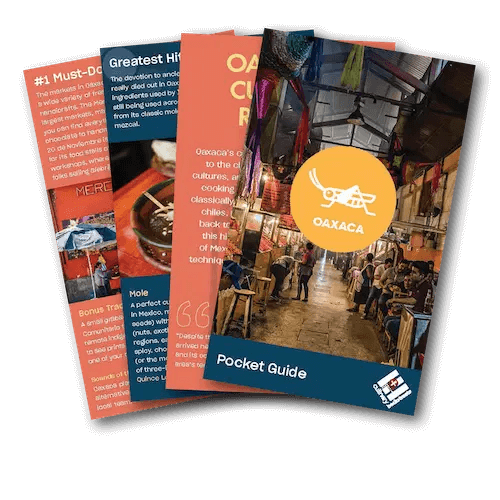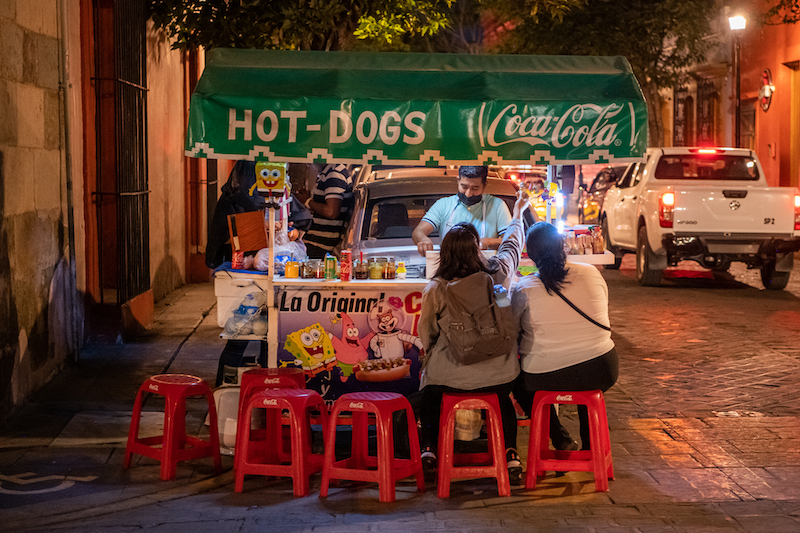We can't find the internet
Attempting to reconnect
Something went wrong!
Hang in there while we get back on track
Oaxaca's culinary record
Oaxaca's deep culinary heritage is, like in many places, a result of its geography: a big valley formed by small ones, all surrounded by mountains, rich soil and warm weather. In fact, this valley reminds us of a clay pot, much like the kind used to make the area’s signature dish, mole, in which many ingredients are mixing, aging and melting together to become something new over the heat of the fire.
Get the Full Story →
Get Your Free Oaxaca Pocket Guide
Introducing our pocket-sized Oaxaca guide — perfect for your next culinary adventure. Yours free when you sign up for our newsletter.
Get Your Free Oaxaca Pocket Guide
Introducing our pocket-sized Oaxaca guide — perfect for your next culinary adventure. Yours free when you sign up for our newsletter.
Visual Dispatches from the Frontlines of Local Eating
Oaxaca Videos
Your Questions, Answered
Oaxaca is a city in the southern region of Mexico, six hours south of Mexico City. It is in a valley surrounded by different mountain chains that go all the way through the country to the Pacific Ocean. This particular geography makes it the culinary heart of the country, as the mountains hold different landscapes with all sorts of climates. It is also the birthplace of some of the most respected Mexican painters and politicians.
One of the most famous dishes in Oaxaca city is Tlayuda It is a crispy, 30-cm folded crispy tortilla with black bean paste, string cheese, cabbage, avocado, salsa and grilled meat (beef or chorizo) and pork lard (both of which are optional). Mornings cannot go by without a hot water chocolate with a piece of egg yolk bread and some memelas, enfrijoladas or entomatadas. Oaxaca is also famous for its seven varieties of mole, which you should definitely try, at least the yellow, the black and the green one. Make sure to add snacks in between meals: some plain grasshoppers and roasted garlic with a glass of beer or a mezcal. The sherbet-like ice creams and fruit-flavored waters are always a good option on spring and summer days.
Americans are welcome in Oaxaca, there are no special visa or Covid requirements in place for short-stay tourists.
Although the center of Oaxaca is mostly flat, with the exception of the steep streets surrounding it, the city is not very stroller-friendly. It does have an interesting offer of libraries for children and a couple of plazas and parks that have space for kids to run, or enjoy the small but lovely public playground. High seasons (Holy Week, Guelaguetza, Day of the Dead and Christmas) can get extremely crowded, but the rest of the year the amount of people walking and enjoying the city is far from overwhelming.
Oaxaca city is most famous for mezcal, food, art and the impressive diversity of indigenous cultures and languages, as it is the most diverse state in the country. It also has some impressive desert-like landscapes like the petrified waterfalls of Hierve el Agua, which are a type of mineral hot spring. Its historic sights trace the story of the city, from the native old ones like Mitla and Monte Alban, to the impressive baroque colonial churches, like Santo Domingo. In Oaxaca, celebrations are an everyday thing. The city is always witness to parades and musical performances, all of which is complemented by the bohemian ambiance found in the streets all day long. Nightlife can be even more lively, with dancing and art events spiced by the flavors of mezcal.
The best time to visit Oaxaca City is August to February. This long period of the year is ideal at any point, as Oaxaca seems to live under a perpetual spring. August is warm and fresh with rain, while autumn (September-December) and winter (January-February) have lovely weather with sunny days that aren’t too hot, and cool nights.
It is relatively easy to fly into Oaxaca City, it all depends on your origin city. While there are direct flights from Houston, Dallas and Los Angeles, most international flights require connections through a bigger city. You can either fly into Merida, Cancun, Guadalajara or Mexico City, and then fly directly to Oaxaca. Make sure to check the flights, as some of these destinations only offer one direct flight into Oaxaca. Once in Oaxaca’s airport, the best way to go to the city is by either the collective airport shuttle or in private taxis. You will find them waiting for the passengers right in the parking area of the airport.
Options in Oaxaca city are countless, but some of our favorite spots are as follows. For breakfast: the Sanchez Pascuas or the Merced Markets, as well as the Memelas de San Agustin street stall, Pan con Madre and Oscuro Brebaje Café. Lunch can be super exciting if you make sure to visit Levadura de Olla, or a great lunch street stall, the tacos del Carmen. For dinner, make sure to visit Ancestral, Origen, or Crudo.
The state of Oaxaca has breathtaking beaches that open into the Pacific Ocean. Warm emerald waters wait for you at the end of a windy road of dreamy cloud forests. Some of of these beautiful tropical spots are Puerto Escondido, Huatulco, San Agustinillo and Mazunte. You can get to many of these in 6 hours by car or 8-12 hours by public transport. There are also a couple of direct 30-min flights in a small airplane, but tickets’ prices can fluctuate considerably due to the scarce offer vs demand. Another good option is to fly to the Oaxacan coast directly from Mexico City.
Generally, the climate in Oaxaca City is sunny and dry, with some windy afternoons almost all year long. In autumn, the weather is sunny and slightly more humid, and temperatures range from 70 to 55 F. While winters can be a bit cool, it’s still sunny – not so different from autumn. Summers are more humid, and we can have some heavy rains or spontaneous but intense showers. Summers are hot if there isn’t enough rainfall. If going during March to early June, we recommend taking an umbrella or a hat, or anything that will protect you from the sun, as well as sunblock and clothes that will keep you cool.
Just like the rest of Mexico, Oaxaca City has quite a high vaccination rate of about 65-75%. There are no official mandates in place, but some shops, galleries and other spaces require the use of masks indoors. Using the mask in the streets is optional and many people still choose to do it. There are no further requirements for traveling to Mexico or Oaxaca.
In general, Oaxaca is a very safe city. Like in any place in the world, if you are not looking after your belongings or you are displaying expensive photographic equipment, you can always get undesired attention. In general people are friendly and a smile and polite words will always get you far.
The Historic Center and the neighborhoods of Jalatlaco and Xochimilco are the best areas to stay in Oaxaca City when you are visiting for the first time. They are close to most restaurants, shops, cafes, historical sites, galleries and nightlife, and they are well connected in terms of transportation. However, if you are acquainted with the city, you might want to explore the northern areas of San Felipe and Colonia Reforma. These two neighborhoods are quieter than the centro and have interesting markets and spots to explore. San Felipe is closer to nature and a lot of people often rent cars to move across the city. Colonia Reforma has the best of two worlds: It is close enough to the center, but also close enough to San Felipe’s green areas and main routes to some of the most interesting villages and nature around the city.
Prices in Oaxaca are usually lower than in big American cities, though this varies widely. Markets are cheaper than touristic or high-end places. The average price of a 3-star hotel is about $50, a cup of coffee or beer under $2, and a sit-down dinner can run anywhere from $12-50. The street food offer, for example, is superb, and prices are considerably lower than restaurants. While the historic center of Oaxaca is relatively small and most things are within walking distance, taxi fares start at a minimum of $3.















































